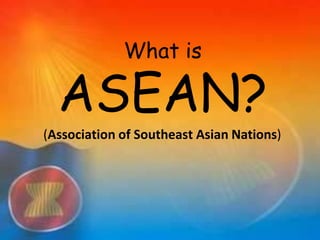
Association of Southeast Asian Nation (Contemporary World)
- 1. What is ASEAN? (Association of Southeast Asian Nations)
- 2. Association of Southeast Asian Nation s (ASEAN) • The ASEAN was founded on August 8, 1967. • The Foreign Ministers of Indonesia, Malaysia, the Philippines, Singapore and Thailand – sat down together in the main hall of the Department of Foreign Affairs building in Bangkok, Thailand and signed a document. By virtue of that document, the Association of Southeast Asian Nations (ASEAN) was born.
- 3. • The five Foreign Ministers who signed it – Adam Malik of Indonesia, Narciso R. Ramos of the Philippines, Tun Abdul Razak of Malaysia, S. Rajaratnam of Singapore, and Thanat Khoman of Thailand – would subsequently be hailed as the Founding Fathers of probably the most successful inter-governmental organization in the developing world today. And the document that they signed would be known as the ASEAN Declaration.
- 4. • ASEAN is a regional grouping that promotes economic, political, and security cooperation among its ten members: Brunei, Cambodia, Indonesia, Laos, Malaysia, Myanmar, the Philippines, Singapore, Thailand, and Vietnam. • In 1976, the members signed the Treaty of Amity and Cooperation, emphasizing ASEAN's promotion of peace, friendship, and cooperation to build solidarity.
- 5. • The ASEAN Emblem represents a stable, peaceful, united and dynamic ASEAN. The colors of the Emblem — blue, red, white and yellow — represent the main colors of the state crests of all the ASEAN MemberStates. • The blue represents peace and stability. Red depicts and dynamism, shows purity and courage white yellow symbolizes prosperity. • The stalks of padi in the centre of the Emblem represent the dream of ASEAN’s Founding Fathers for an ASEAN comprising all the countries in Southeast Asia, bound together in friendship and solidarity. • The circle represents the unity of ASEAN.
- 7. • Thailand • Myanmar • Cambodia • Laos • Brunei • Vietnam • Malaysia • Singapore • Philippine s • Indonesia
- 8. Some of the joint development programs first undertaken by ASEAN include projects to: v increase food production v promote tourism v ease travel restrictions, and mass media through exchanges venhance cooperation in the field of radio and television programs. vPlans were also put in place to liberalize trade among members in a bid to improve intraregional trade.
- 9. • Today, ASEAN is considered one of the most successful intergovernmental organizations in the developing world. Since its founding, the grouping has expanded to include other Southeast Asian states – Brunei (1984), Vietnam (1995), Laos (1997), Myanmar (1997) and Cambodia (1999).
- 10. AIMS AND PURPOSES As set out in the ASEAN Declaration, the aims and purposes of ASEAN are: • To accelerate the economic growth, social progress and cultural development in the region through joint endeavors in the spirit of equality and partnership in order to strengthen the foundation for a prosperous and peaceful community of Southeast Asian Nations.
- 11. • To promote regional peace and stability through abiding respect for justice and the rule of law in the relationship among countries of the region and adherence to the principles of the United Nations Charter; • To promote active collaboration and mutual assistance on matters of common interest in the economic, social, cultural, technical, scientific and administrative fields; • To provide assistance to each other in the form of training and research facilities in the educational, professional, technical and administrative spheres;
- 12. • To collaborate more effectively for the greater utilization of their agriculture and industries, the expansion of their trade, including the study of the problems of international commodity trade, the improvement of their transportation and communications facilities and the raising of the living standards of their peoples; • To promote Southeast Asian studies; and • To maintain close and beneficial cooperation with existing international and regional organisations with similar aims and purposes, and explore all avenues for even closer cooperation among themselves.
- 13. Fundamental Principles In their relations with one another, the ASEAN Member States have adopted the following fundamental principles, as contained in the Treaty of Amity and Cooperation in Southeast Asia (TAC) of 1976: • Mutual respect for the sovereignty, equality, territorial independence, integrity, and national identity of all nations; • The right of every State to lead its national existence free from external interference, subversion or coercion;
- 14. • Non-interference in the internal affairs of one another; • Settlement of differences or disputes by peaceful manner; • Renunciation of the threat or use of force; and • Effective cooperation among themselves.